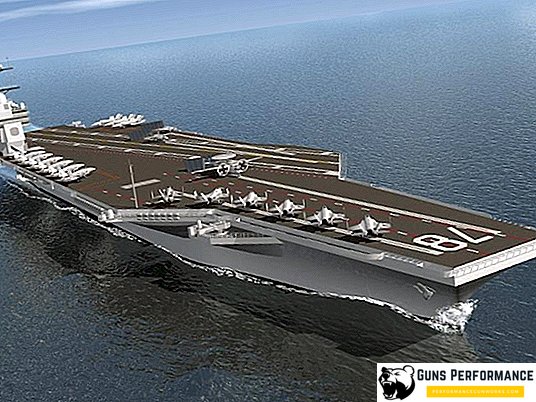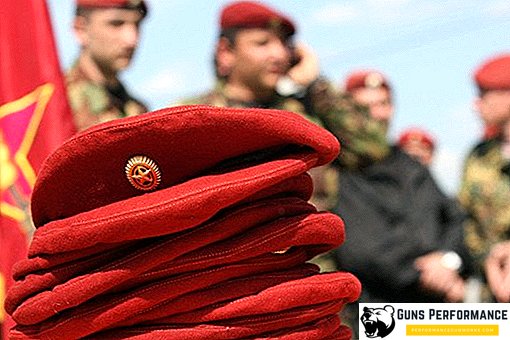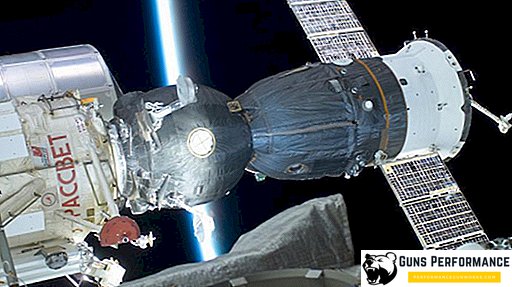
On May 25, 1971, an IL-76 transport aircraft first flew into the sky, and three years later this vehicle was put into service with the Soviet army. Since then, for several decades the IL-76 has been the basis of domestic military transport aviation. Despite his rather advanced age, he continues to regularly serve in the air forces of Russia, Ukraine, Kazakhstan, India, China, Iran and many other countries.
During serial production, about 1,000 machines of various modifications were produced. More than a hundred aircraft were exported. At present, about 120 military transport Il-76s are in service with the Russian VKS.
The Il-76 became a real symbol of the Airborne Forces, since one of the main purposes of this aircraft is the landing of "winged infantry" and various types of military equipment. This aircraft remains to this day the main transport vehicle of the Russian Airborne Forces.
For a characteristic body bend, Soviet aviators and paratroopers nicknamed the IL-76 "humpbacked". It is curious that exactly the same nickname was worn by another legendary machine of the Ilyushin Design Bureau - the famous Il-2 attack aircraft of the period of the Great Patriotic War.
Of course, the IL-76 is one of the best transport aircraft created by Soviet aircraft manufacturers, but more than forty years have passed since its introduction. The machine clearly needs to be updated. Currently, the “476 project” is in the final stage, which provides for a deep modernization of the Il-76 transport aircraft.
The implementation of this ambitious program is carried out by Aviastar Aviation Plant specialists (Ulyanovsk). In the future, it is planned to launch mass production of the new IL-476 at this plant. In fact, the IL-476 (“product 476”) is the unofficial designation of the aircraft: the modification to which the “humpback” will be improved is called the IL-76-MD-90A.

In fact, it will be a new aircraft with more advanced flight performance and a much longer service life. Modernization of the machine involves the replacement of the main components of the structure.
Currently, IL-476 aircraft are at the stage of state testing, it is planned that until 2020, 39 similar machines will be manufactured at Aviastar. The cost of one aircraft will be approximately 3.5 billion rubles.
The history of the project IL-476
The development of the IL-76 transport aircraft began in the mid-60s of the last century. The fleet of military transport aviation existing at that time clearly did not meet the needs of the Soviet armed forces. Two design bureaus, Ilyushin and Antonov, took part in the competition for the creation of a new heavy transport worker.
Antonov Design Bureau proposed to carry out a deep modernization of the honored An-12, while the Ilyushins came up with a project of a fundamentally new heavy transport aircraft, the IL-76. He eventually gave preference.
The IL-76 can be called one of the most successful machines of the Ilyushinsky design bureau, it became popular with aviators and became one of the main aircraft of the Soviet military transport aircraft. Production of IL-76 was deployed at the Tashkent Aviation Plant.

This machine was actively used to supply the contingent of Soviet troops in Afghanistan, it deservedly became one of the symbols of this war. However, in the late 80s, it became clear that the “hunchback” needs modernization. At about the same time, the new PS-90A engine was created, which could be used to equip the car. But the collapse of the USSR and the years of economic crisis did not allow the fulfillment of the plans. However, they were not forgotten.
In 2006, a fundamental decision was made to transfer the production of the IL-76 from Uzbekistan to Russia. At that time, Aviastar Aviation Plant, originally created for the construction of large aircraft, was loaded at a minimum.
On April 3, 2006, an urgent meeting of the management team was convened at the enterprise, following which a proposal was submitted to the United Aircraft Building Corporation to organize the production of IL-76 at the plant’s facilities. The letter contained complete information about the capabilities of the enterprise, its equipment, personnel qualifications, and the level of technology development. The possible rates of aircraft production that the Aviastar team could provide were also indicated.
Already in July of the same year, a government decree was issued on the organization of the serial production of the Il-76 in Ulyanovsk. This project received the designation 476. Later, these figures will become the unofficial designation of a new transport aircraft from the Il-76 line.

The development of the IL-476 was completed by 2009. This car was the first "digital" project for designers from Ulyanovsk. If before that the planes were manufactured using the plasma-template method, often cutting out full-size metal parts, then the IL-76MD-90A drawings were prepared electronically, and only a small part of them were made on paper. Designers had to make a lot of effort to learn new technologies.
Around the same time, India became interested in the new, modernized IL-76 aircraft. Prospects for cooperation were promising: in 2009 they planned to conclude a contract, in 2010 - to build the first prototype of the machine, and in 2011 to launch mass production. Construction of the prototype really began in 2009, but it was delayed until 2011. Only in December, the first demonstration of the car took place - a solemn rolling out of the aircraft from the factory hangar.
The first flight of the IL-76MD-90A transporter took place on September 22, 2012. The machine under the control of an experienced crew of test pilots made a forty-minute flight, which passed without incident.
In early 2013, the tests of the IL-476 aircraft were continued at the LII them. Gromov.

In 2016, the director of Aviastar, Sergei Dementiev, said that four states were already interested in the Il-76 plane: Kazakhstan, Algeria, Iran and South Africa. He stressed that he believes in the great future of the new machine. According to the official, at that time about ten new aircraft were being built, which were in varying degrees of readiness. Two years earlier, Aviastar’s management stated that the plant’s capacity allows it to assemble 6–8 airplanes per year, and by 2018 the plant plans to increase annual production to 18 vehicles.
Ulyanovsk aircraft manufacturers believe that the new modified IL-476 is quite capable of making serious competition to Western transport vehicles. After all, it has almost no analogues among air ramp vessels. The most important advantage, which, however, is characteristic of many domestic cars, is the unpretentiousness of the new aircraft. IL-76MD-90A is able to work in any climatic conditions without any restrictions. It is much more reliable than its Western counterparts, less demanding on the quality of the runways, and its maintenance is also cheaper. These are the most important qualities for airplanes that are forced to work in hard-to-reach areas.
The creators claim that the new machine will be designed for 35 years of operation, perhaps even the extension of this period to 45 years.
However, despite possible overseas orders, most aircraft builders are counting on the Russian Ministry of Defense, which plans to buy several dozen Il-476 aircraft by 2020. Repeatedly in the media appeared information about the desire of the military to buy a batch of aircraft of 50 or even 100 cars.
In 2012, a contract was signed between the Russian Ministry of Defense and the United Aircraft Building Corporation for the supply of 39 Il-76MD-90A aircraft until 2020. At that time, the total amount of the transaction amounted to 140 billion rubles. A little later, information appeared about the order for two hundred PS-90A-76 engines, which was received by Perm Engine Company OJSC. It is these engines will be equipped with serial IL-476.

The military plan to use the IL-76MD-90A not only as a transport vehicle, but also to create on its base a tanker truck and a DRLO A-100 Premier aircraft. In 2013, the media reported that the first Il-476 had already been laid on the Aviastar in a modification of the tanker aircraft.
In addition, the military are considering the possibility of using the IL-476 as an air command post for the commanders of fleets and districts instead of the IL-22, created in the mid-60s and having served its time long ago.
An interest in the IL-76MD-90A is shown by the Russian Emergencies Ministry, they are eyeing the aircraft of the Ministry of Internal Affairs and the Federal Security Service of Russia.
If we talk about the latest news related to the project, in the middle of June it was announced that tests of the DRLO aircraft based on the IL-476 will begin as early as this year. Representatives of "Rostec" told reporters that work on the A-100 "Premier" are in the final stages. Back in 2016, Sergei Shoigu said that this DRLO aircraft would surpass most foreign analogues in its technical characteristics. It can be used to monitor the ground, air and surface situation.
There is information that as of January 2018, 6 aircraft were assembled.
Machine design
Despite the fact that the IL-476 is virtually indistinguishable from the basic modification of the aircraft, in its "stuffing" and characteristics - this is a fundamentally new machine. What are the main differences of IL-76MD-90A?

At present, the manufacture of the airframe is fully carried out at the Aviastar plant. Initially, elements of the mechanization of the Il-76 wing were made in Tashkent, but then their production was also transferred to Russia. The chassis is manufactured at the Samara PO "Aviaagregat".
Particularly noteworthy wing IL-76MD-90A, which has a modified design. Earlier, at the Tashkent Aviation Plant it was made of several parts (4 in width and 3 in length), now this most important element of the aircraft structure is made of long panels up to 25 meters long. One wing requires up to four such segments in width. The power frame of the wing is made in a new way: now the stringers are made separately and only then are connected to the panels. In this case, the contour of the wing remained the same. Such innovations not only speed up the assembly, but also greatly simplify the design. Thanks to the use of lengthy panels, it was possible to reduce the weight of the aircraft by 2.7 tons. The power circuit of the IL-476 wing is in many ways reminiscent of a similar design of another Illyushin aircraft - the IL-96-300.

The aircraft’s landing gear is similar to that used on the IL-76, but its design is enhanced due to the higher mass of the vehicle.
The cargo cabin of the IL-476 is equipped with a large number of landing-loading equipment, which allows the aircraft to perform a number of functions:
- transportation of personnel;
- parachute landing of military personnel;
- transportation of equipment, cargo, standard aviation and sea containers, as well as pallets;
- carry out parachute landing of equipment and cargo on special platforms;
- non-parasite dumping of various loads from low altitudes.
For loading equipment and cargo cargo door is used, as well as various devices: hoists and winches. The latter allow loading with effort on each cable up to 3 thousand kgf. They have both electric and manual drive. Four hoists located in the cargo compartment allow you to load a unit load weighing up to 10 tons. There is a ramp that can be installed in any convenient position. For loading different types of equipment - tracked or wheeled - used trailers (four), providing a smooth entry.
On the floor of the cargo cabin and on the ramp there are four roller tracks. For the carriage of passengers in the cargo compartment side seats are provided, you can also install additional seats in the central part of the cabin. In the plane with one deck 145 soldiers or 126 paratroopers are placed, a double-decker car can take on board 225 soldiers.
In addition, the IL-476 aircraft is equipped with a cargo discharge system that allows for single or serial landing of equipment and cargo platforms.
The maximum carrying capacity of the IL-476 is 60 tons.
IL-476 can be converted into a medical or fire fighting aircraft. In this case, he is able to transport up to 114 wounded people in the cargo compartment together with the medical staff, or it can carry out resuscitation measures for 20 seriously wounded people on board.
The power plant IL-76-MD-90A consists of four PS-90A-76 engines, each of them has a thrust of 14,500 kg (according to other data, 16,000 kg). PS-90A-76 is 17-19% more economical than the D-30KP-2 engine. The fuel consumption of the IL-476 engine is only 0.595 kg / kgf per hour, which is significantly lower than that of its predecessors.
New engines fully comply with international standards for the level of harmful emissions into the atmosphere and noise. This fact is very important, since compliance with international requirements will help open up for the new Russian machine the most interesting markets of the USA and Europe. Europeans constantly criticize Russian aircraft for their noise, but in this case this problem seems to be solved: IL-476 meets the standards of Eurocontrol, FAA USA and ICAO.
The crew of IL-76-MD-90A consists of five people. Compared to the base model of the aircraft, their jobs have undergone significant changes. The car received a new complex of onboard radio-electronic equipment, with the newest KNTU-III-76M PrNPK.
Digital autopilot allows pilots to land in the so-called second category of ICAO. When landing, the device brings the car to a height of 30 meters, after which the control is intercepted by a person and carries out the landing. The previous modifications of the IL-76 belonged to the first category, when the automatic equipment led the plane to a height of 60 meters. This refinement is very important, because it allows you to significantly expand the geography of aircraft operation, including in it, first of all, European countries, where weather conditions are often difficult.

Another difference IL-476 is the presence of the so-called glass cabin. The pilots of this aircraft will no longer use familiar analog devices, instead they have digital indicators and LCD screens. There are eight of them in the cockpit. Six screens provide information to the pilots, two more - to the navigator. The screens are more informative, they give crew members comprehensive information that allows them to make decisions faster. All this will significantly reduce the load on the crew, and thus increase the safety of operating the aircraft.
The principle of open architecture, used in the creation of the aircraft navigation complex, allows you to include in its structure any equipment of domestic or foreign production.
There is one more nuance connected with the work of the crew, or rather, with its convenience. IL-476 was the first domestic transport aircraft, which has a full washbasin, and most importantly, the toilet. Although it looks frivolous compared to the engine power of a car or its navigation complex, in fact, it is no less important. Despite the complex electronics, the aircraft is controlled by people, which means that their level of comfort ensures their physical condition and safety.

The toilet is located in the nose of the aircraft in an airtight compartment. There is a biological waste tank that holds 28 liters. Additional toilets can be installed in the cargo cabin during the transport of paratroopers. Airborne veterans said that the lack of a toilet was very difficult to sustain during long-haul flights, while pilots usually used a bucket for these purposes. By the way, the cost of such a toilet stall can be from 50 to 150 thousand dollars.
In addition, the IL-476 will be equipped with a small module with a stove and boiler.
It should be noted, and another feature of the IL-476, namely the color of its fuselage. The fact is that for it for the first time domestic polyurethane enamels were used. They were specially developed at the Aviation Materials Research Center for this project.
Using these paints allows you to get a matte, not a glossy surface. New enamels are better placed on the surface and held stronger. They better protect the hull from aggressive chemicals and temperature changes. This property is difficult to overestimate, since it significantly reduces the cost of maintaining the aircraft.
Specifications
| Modification | IL-76MD-90A |
| Wingspan, m | 50.50 |
| Aircraft length, m | 46.59 |
| Airplane height, m | 14.76 |
| Wing area, m2 | 300.00 |
| Weight, kg | |
| empty | 92000 |
| Max. takeoff | 190000 |
| payload | 48000-50000 |
| engine's type | 4 TRD PS-90A-76 |
| Thrust, kgf | 4 x 14,500 |
| Max. speed, km / h | 830-850 |
| Cruising speed, km / h | 750-800 |
| Range, km | |
| with a load of 20 tons | 8500 |
| with a load of 52 tons | 5000 |
| Practical ceiling, m | 12100 |
| Crew | 5 |












